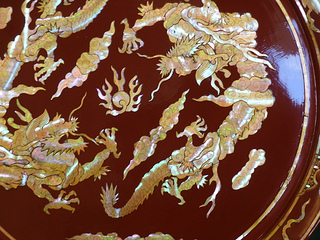Difference between revisions of "Ryukyu lacquerware"
m (LordAmeth moved page Ryukyu lacquer to Ryukyuan lacquerware: less awkward, more proper phrase) |
|||
| Line 7: | Line 7: | ||
''Hakue'' involved simply placing pieces of gold leaf atop lacquered surface, while ''chinkin'' techniques (lit. "submerged/sunken gold") involved carving into the lacquered surface, and then filling in the space with gold leaf or gold powder. Chinese techniques of lacquer carving never took off in Ryûkyû, but instead, techniques of building up designs in relief using a lacquer putty, called ''[[tsuikin]]''<!--堆錦-->, became a distinctive element of Ryukuyan lacquerwares. Ryûkyû lacquer also often made use of basketry skeletons for boxes and other objects. | ''Hakue'' involved simply placing pieces of gold leaf atop lacquered surface, while ''chinkin'' techniques (lit. "submerged/sunken gold") involved carving into the lacquered surface, and then filling in the space with gold leaf or gold powder. Chinese techniques of lacquer carving never took off in Ryûkyû, but instead, techniques of building up designs in relief using a lacquer putty, called ''[[tsuikin]]''<!--堆錦-->, became a distinctive element of Ryukuyan lacquerwares. Ryûkyû lacquer also often made use of basketry skeletons for boxes and other objects. | ||
| + | |||
| + | Built around a core of ''[[deigo]]'' wood, Ryukyuan lacquerwares were traditionally exceptionally lightweight. In modern times, however, the wood of the ''gajumaru'' ([[banyan]] tree) has replaced the use of ''deigo''.<ref>Guided tour at Okinawa Rekishi Minzoku Shiryôkan, Nago, Okinawa, Sept 19, 2014.</ref> | ||
Lacquerware objects, especially with mother-of-pearl inlay, were common [[tribute]] or gift items sent to both China and Japan; an entire office, the ''[[kaizuri bugyo|kaizuri bugyô]]'' ("Mother-of-Pearl Magistrate") was dedicated to overseeing the production of these and other objects. | Lacquerware objects, especially with mother-of-pearl inlay, were common [[tribute]] or gift items sent to both China and Japan; an entire office, the ''[[kaizuri bugyo|kaizuri bugyô]]'' ("Mother-of-Pearl Magistrate") was dedicated to overseeing the production of these and other objects. | ||
| Line 17: | Line 19: | ||
*Failla, Donatella. "[http://venus.unive.it/okinawa/en/sunti/failla.html Ryukyu lacquerware in the Chiossone Museum of Oriental Art, Genoa]." Abstract for presentation at 5th International Conference on Okinawan Studies, Ca' Foscari University of Venice, 14-16 September 2006. | *Failla, Donatella. "[http://venus.unive.it/okinawa/en/sunti/failla.html Ryukyu lacquerware in the Chiossone Museum of Oriental Art, Genoa]." Abstract for presentation at 5th International Conference on Okinawan Studies, Ca' Foscari University of Venice, 14-16 September 2006. | ||
*Gallery labels, Naha City Museum of History, August 2013. | *Gallery labels, Naha City Museum of History, August 2013. | ||
| + | <references/> | ||
[[Category:Art and Architecture]] | [[Category:Art and Architecture]] | ||
[[Category:Ryukyu]] | [[Category:Ryukyu]] | ||
Revision as of 18:15, 3 November 2014
- Japanese: 琉球漆器 (Ryuukyuu shikki)
Lacquer techniques were introduced to Ryûkyû from China in the late 14th century; Ryukyuan lacquer styles continued to draw heavily on these techniques down through the centuries, until the 19th century.
These included raden (mother-of-pearl inlay), an engraved gold technique (chinkin), gold leaf (hakue), painting in gold (kindeie), colored lacquers (iro-urushie), and lead-based pigments (mitsudae). Raden was first introduced to Ryûkyû in 1690, by Ômitake Hyôbu, who had studied such techniques in China.
Hakue involved simply placing pieces of gold leaf atop lacquered surface, while chinkin techniques (lit. "submerged/sunken gold") involved carving into the lacquered surface, and then filling in the space with gold leaf or gold powder. Chinese techniques of lacquer carving never took off in Ryûkyû, but instead, techniques of building up designs in relief using a lacquer putty, called tsuikin, became a distinctive element of Ryukuyan lacquerwares. Ryûkyû lacquer also often made use of basketry skeletons for boxes and other objects.
Built around a core of deigo wood, Ryukyuan lacquerwares were traditionally exceptionally lightweight. In modern times, however, the wood of the gajumaru (banyan tree) has replaced the use of deigo.[1]
Lacquerware objects, especially with mother-of-pearl inlay, were common tribute or gift items sent to both China and Japan; an entire office, the kaizuri bugyô ("Mother-of-Pearl Magistrate") was dedicated to overseeing the production of these and other objects.
Ryûkyû lacquers are among the most common Ryukyuan artworks to find in museum collections in the West, alongside pottery and textiles; paintings and works of calligraphy are far less common.
References
- Failla, Donatella. "Ryukyu lacquerware in the Chiossone Museum of Oriental Art, Genoa." Abstract for presentation at 5th International Conference on Okinawan Studies, Ca' Foscari University of Venice, 14-16 September 2006.
- Gallery labels, Naha City Museum of History, August 2013.
- ↑ Guided tour at Okinawa Rekishi Minzoku Shiryôkan, Nago, Okinawa, Sept 19, 2014.
